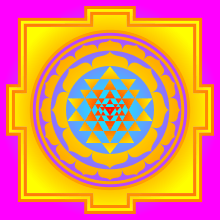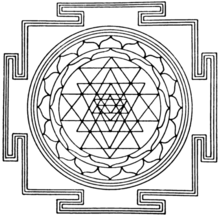Sri Yantra


The Sri Yantra is a form of mystical diagram, known as a yantra, found in the Shri Vidya school of Hindu tantra. The diagram is formed by nine interlocking triangles that surround and radiate out from the central (bindu) point. The two dimensional Sri Chakra, when it is projected into three dimensions is called a Maha Meru. Mount Meru derives its name from this Meru like shape.
It represents the goddess in her form of Shri Lalita or Tripura Sundari, "the beauty of the three worlds" - Bhoo, Bhuva and Swa. (Earth, Atmosphere and Sky(heaven)). The worship of the Sri Chakra is central to the Shri Vidya system of Hindu worship. Four isosceles triangles with the apices upwards, representing Shiva or the Masculine. Five isosceles triangles with the apices downward, symbolizing female embodiment Shakti. Thus the Sri Yantra also represents the union of Masculine and Feminine Divine. Because it is composed of nine triangles, it is known as the Navayoni Chakra.[1]
"These nine triangles are of various sizes and intersect with one another. In the middle is the power point (bindu), visualizing the highest, the invisible, elusive centre from which the entire figure and the cosmos expand. The triangles are enclosed by two rows of (8 and 16) petals, representing the lotus of creation and reproductive vital force. The broken lines of the outer frame denote the figure to be a sanctuary with four openings to the regions of the universe".[2]
In a recent issue of Brahmavidya, the journal of the Adyar Library, Subhash Kak argues that the description of Sri Yantra is identical to the yantra described in the Śvetāśvatara Upanisad.[3]
Together the nine triangles are interlaced in such a way as to form 43 smaller triangles in a web symbolic of the entire cosmos or a womb symbolic of creation. Together they express Advaita or non-duality. This is surrounded by a lotus of eight petals, a lotus of sixteen petals, and an earth square resembling a temple with four doors.[1] The various deities residing in the nine layers of the Sri Yantra are described in the Devi Khadgamala Mantra.
The Shri Chakra is also known as the nav chakra because it can also be seen as having nine levels. "Nine" comes from "Nau or Nava" of Sanskrit. Each level corresponds to a mudra, a yogini, and a specific form of the deity Tripura Sundari along with her mantra. These levels starting from the outside or bottom layer are:[1]
- Trailokya Mohan or Bhupar, a square of three lines with four portals
- Sarva Aasa Paripurak, a sixteen-petal lotus
- Sarva Sankshobahan, an eight-petal lotus
- Sarva Saubhagyadayak, composed of fourteen small triangles
- Sarva Arthasadhak, composed of ten small triangles
- Sarva Rakshakar, composed of ten small triangles
- Sarva Rogahar, composed of eight small triangles
- Sarva Siddhiprada, composed of 1 small triangle
- Sarva Anandamay, composed of a point or bindu
The Sri Chakra (called the Shri Yantra) is the symbol of Hindu tantra, which is based on the Hindu philosophy of Kashmir Shaivism. The Sri Yantra is the object of devotion in Sri Vidya.
A Sri Yantra without error https://www.geogebra.org/m/cuCmHY4G Luke Williams
In temples
- Aadi shankaracharya sthapita Dharma mahasamsthana Dakshninamnaya Peetham sringeri sharadamba temple .
- Maa Pitambara Bagulamukhi Mahakal Temple Guraiya Chindwara Madhya Pradesh India[4]
- Śri Chakra Mahameru Peetham in Koradacheri,Tamil Nadu
- Śhree Kshetra Hedavde Mahalaxmi, Optimised Sri Yantra intsalled by Sri Sri Dada Hatey
- Pashupatinath Temple, Nepal, At the roof of Ganga Mai temple (This temple is carved in shape of meru shri yantra)
- Śri Chakra Man with 10 claws, Blacktown Temple, Shivashivashivamanium
- Śri Yantra carved on Stone in Mahalaxmi Temple Kolhapur Maharashtra, it installed by Adi Shankaracharya.(This temple is shape of meru shri yantra)
- Adiparashakti (Tripurasundari Rajarajeshwari) Chapel, Anand Ashram Ubud (Bali) - where the Personification or Vigraha of Śri Yantra is installed and worshiped daily
- Kamakshi temple, Jonnawada, Nellore
- Kamakshi temple, Kanchipuram
- Kalikambal temple, Chennai
- Kamakshi temple, Mangadu, Chennai
- Śri Kali Temple, Out side Sanganeri Gate, MotiDunri Road, Jaipur
- Nimishamba temple, SriRangapatana, Mysore District.
- Prasanna Meenakshi Temple, Shivanasamudra, Malavalli Tk, Mandya Dist,Karnataka.
- Kollur Mookambike Temple, Udupi dist, Karnataka
- Matrubhuteshwar Temple, Sri Ramanasramam, Tiruvannamalai installed by Bhagavan Ramana Maharshi
- At Kamakhya Temple, Guwahati, Assam (This mandir itself in the shape of shree yantra)
- Puthenkavil Devi Temple, Cherumukha, Nooranad, Alapphuzha, Kerala
- Śri Tyagarajaswamy udanurai Vadivudai amman temple Thyagaraja Temple, Tiruvottiyur
- Śri Chakra MahaMeru Temple in Thrikkuttissery, near Balussery in Kozhikode District, Kerala, India.
- Sri Maha Meru engraved in rock inside the Arapaleeshwarar Shiva temple, Kolli Hills
- Sri Mah Meru Dhyana Nilayam, Panruti-Kandigai, Near Oragadam (Royal Enfield Factory), 631604
- Shri Laxminarayan Temple, Orchha, Madhya Pradesh.
- Shri Raja Rajeshwari Temple, RR nagar, Mysore Road, Bangalore
- Sri Narasimha Swamy Temple (9 Temple Complex), Aho Bilam, Andhra Pradesh 518553
See also
References
- 1 2 3 Shankaranarayanan, S. (1979). Sri Chakr (3rd ed.). Dipti Publications.
- ↑ Kuiper, K (2011). Understanding India: The Culture of India. Britannica Educational Publishing. ISBN 9781615302031.
- ↑ http://ikashmir.net/subhashkak/docs/SriChakra.pdf Subhash Kak, The Great Goddess Lalitā and the Śrī Cakra. Brahmavidyā: The Adyar Library Bulletin, vol. 72-73, pp. 155-172, 2008-2009
- ↑ www.ubudashram.org